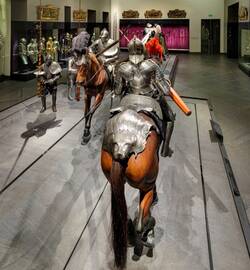Pallienstechen, a form of tilt, was a style of jousting that originated in Italy. It was introduced in German courts around the mid-sixteenth century. In this discipline the two opponents charging towards each other were separated by a wooden barrier known as a pallia. The aim was still to break one’s lance on the opponent’s helmet or on his targe, the shield attached to his shoulder. The armour worn for this was different from that of earlier disciplines. The examples you see here are typical of those worn in Saxony.
In the scene we have re-created here there are three knights on horseback and a number of spectators wearing armour. The combatants, going at full tilt, have just made contact, while a third, waiting to ride against the next contender, has to struggle to stay on his horse, which has taken fright at the sound of lances splintering. The action is watched by two more participants in full armour. The pallia, the wooden barrier separating the two contestants, is represented on the platform by a sheet of glass – so that you can see the riders, their mounts and the other figures from all sides.
The armours here are just some of the gleaming or blackened tourney harnesses that the Electors August and Christian I commissioned for noblemen taking part in their tournaments. Unfortunately the Dresden Rüstkammer collection has no original tournament clothing. For this reason, the garments worn by these figures were specially made – with the greatest care – for this tournament group.
